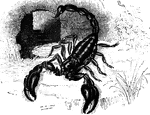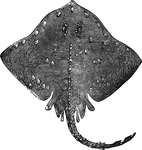
Thornback
"The prevailing color of the upper part, which is rough and with small points, is dark brown, the under…
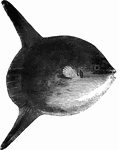
Short Sunfish
"Almost of a circular form, with long dorsal and anal fins, projecting like handles from its inder parts.…

Sapphire Gurnard
"Is two feet long, and is common in the Mediterranean and other European waters; its flesh is good,…

European Bass
"Is one to three feet long, and has been celebrated from the time of Aristotle for its richness and…

European Blackfish
"Two to three feet long, remarkable for its swiftness and voracity; the color is black, the body covered…

Common Tunny
"A large species, four to twenty feet long, and sometimes weighing a thousand pounds." — Goodrich,…

Hawken's Gymnetrus
"Eight to ten feet long, depth ten inches, thickness less than inches; color dusky green; found in the…
Dealfish
"Four to six feet long, breadth eight inches, thickness one inch; found in the North Atlantic, and has…

Scabbard
"Four to six feet long, and swims with great swiftness: the skin is smooth, except a few scales in place…

Silvery Hairtail
"Two to four feet long, of a shiny silvery color; called ribbon-fish on our coast, and sword-fish…

Red Bandfish
"One to two feet long, color orange-red; moving in the waters it appears like a red-ribbon. This, as…
Seawolf
"Three to seven feet long, agreeing with the gobies in the abscence of the air-bladder; the pectoral…

Angler
"The fishing frog is three to five feet long. It has an enormous mouth, armed with numerous pointed…

Gar
"Two feet long, with the under jaw greatly protruded; it swims near the surface; bites at a hook; makes…

Saury Pike
"From one to two feet long, swims in vast shoals, and when chased by the porpoise leaps to the height…

Common Cod
"It is two to four feet long, and weighs from two to seventy spounds; the general color is greenish…

Dorse
"From one to two feet long, varies greatly in color; is common in the Baltic; also found occasionally…
Burbot
"Lives in slow-running rivers, is one to two feet long, conceals itself under stones like an eel, and…

Great Forked-Beard
"One to two feet long, with a long barbule hanging from each chin." — Goodrich, 1859

Halibut
"This is a large species, sometimes measuring seven or eight feet in length, and weighing five or six…

Salmon
"The salmon two to four feet long, and weighs ten to twelve pounds, though it has been taken of eights…

Northern Charr
"A European species, and inhabits the northern lakes of England and those of Scotland; it is from one…
Pickerel
"Is from one to three feet long, and is found in most of the lakes, ponds, and rivers of the Middle…
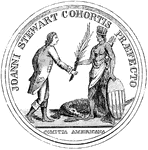
Stewart Medal Front
"Medal awarded to Major Stewart. This represents the medal the size of the original. The device is America…
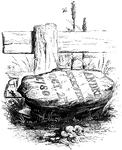
Andre's Execution
"Place of execution. The place of Andre's execution is now designated by a stone, lying on the right…
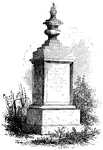
Woodhull's Monument
"Woodhull's Monument. This monument stands on the south side of the church. It is of white marble, about…
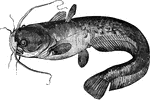
Sly Silurus
"It sometimes attains the length of six feet, and the weight of three hundred pounds. It is a slow and…
Sharp-Nosed Eel
"It is from one to four feet long, and weighs from one to twenty-five pounds. This species feed on frogs…

Conger Eel
"It varies in length from three to ten feet, and in weight from five to one hundred and thirty pounds.…

Battle of Antietam
"Battle of Antietam, Burnside's Division, left wing- brilliant and decisive bayonet charge of Hawkins's…

Battle of Antietam
"Battle of Antietam, Burnside's Division, left wing- brilliant and decisive bayonet charge of Hawkins's…

Hooked squid
"Its length from tail to the end of the tentacles is six feet. The two largest of these are furnished…
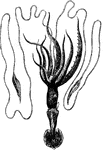
Bonelli's Cheiroteuthis
"Has the body eight inches long, and the longest tentacles nearly three feet." — Goodrich, 1859
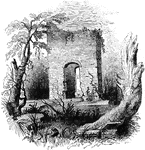
Jamestown Ruins
"Ruins at Jamestown. This view is from the old church-yard, looking toward James River, a glimpse of…
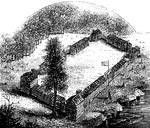
Boone's Fort
"Boone's Fort. This sketch is from a drawing by Colonel Henderson, and published in Collin's Historical…
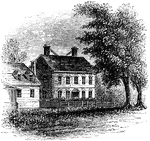
Nelson Mansion
"The Nelson Mansion. This view is from the street looking northwest. A long wooden building, with steep…

British Flag
"British flag. This is a representation of one of the flags surrendered at Yorktown, and presented to…

Greene Medal Back
"Gold medal awarded to Greene. This is a representation of the back side of the medal, the full size…
!["View of the remains of the French Works. These remains are in the southeastern suburbs of the city, about half way between the [African American] Cemetary and the residence of Major William Bowen, seen toward the right of the picture. The banks have an average height, from the bottom of the ditch, of about five feet, and are dotted with pines and chincapins or dwarf chestnuts, the former draped with moss. The ground is an open common, and although it was mid-winter when I was there, it was covered with green grass, bespangled with myriads of little flowers of stellar form. This view is from the direction of the town looking southeast."—Lossing, 1851](https://etc.usf.edu/clipart/14100/14147/french-works_14147_mth.gif)
French Works
"View of the remains of the French Works. These remains are in the southeastern suburbs of the city,…

Washington's Quarters
"Washington's Quarters. This is a view of the southwest front of the mansion. The room occupied by Washington…

Panopaea australis
"The Panopaea Australis is a large analogous species, found at Port Natal, on the coast of…
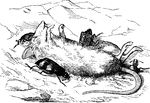
Burying Beetles
"The Burying Beetles are prompted by their insect to bury any small animals or pieces of carrion as…

Angelfish
"A plagiostomous fish. It is from 6 to 8 feet long, has a flat, roundish head, terminal mouth, and teerh…

Aardvark
"Aard-vark is a burrowing insect-eating animal of the order Edentata found in South Africa. The name…
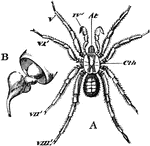
Araneida
"Mygale cæmentaria, typical of Araneida. A, female, natural size: At, cheliceræ; IV', pedipalpi;…
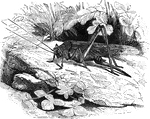
Carolina Grasshopper
"The Carolina Grasshopper, Gryllus Carolina, is a large species with brown wings, common in…

Battering Ram
"The Battering Ram is an ancient military contrivance used for battering down walls. It consisted of…
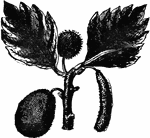
Breadfruit
"The breadfruit is a large, globular fruit of a pale-green color, about the size of a child's head,…

Breadfruit Fruit
"The breadfruit is a large, globular fruit of a pale-green color, about the size of a child's head,…

Cacao Plant
"Cacao, or cocoa, is the chocolate tree, and also the powder and beverage made with it obtained from…

King crab
"It is among the largest of crustaceous animals, sometimes measuring as much as two feet in length.…

Lob-worm
"Errantia means wandering, and is applied to numerous species, of which the Lob-worm or Lug-worm,…
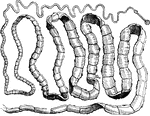
Tape-worm
"The body is composed of numerous joints or segments, each one resembling the others; these are often…
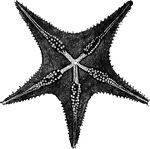
Underside of a starfish
"The organs of motion are similar, consisting of a multitude of small feet called ambulacra,…
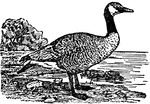
Canada Goose
"The Canada Goose is an American wild goose 30 to 35 inches long, brownish above, lighter below, head,…

Archerfish
"To this fish has been ascribed the power of shooting drops of water to the distance of 3 or 4 feet,…

Coffee Plant
"Coffee is the seed of an evergreen shrub, which is cultivated in hot climates, and is a native of Abyssinia…


